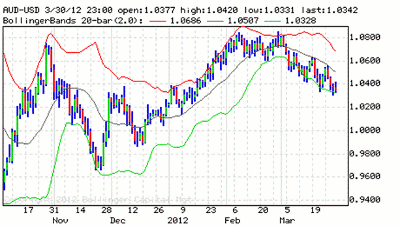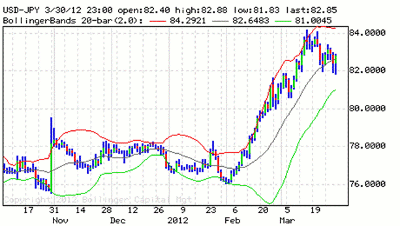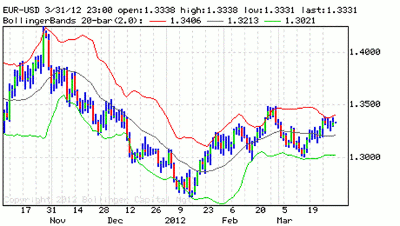Kathleen Brooks and Eric Viloria (CMT) of FOREX.com identify important price levels for major currency pairs and upcoming data and news events that are likely to impact the markets this week.
AUD/USD sees a significant long-term pivot around the 1.04 figure. This is where the 100- and 200-day simple moving averages (SMAs) and a long-term trend line converge. The trend line—which dates back to the lows of October and was prior support for the pair—was breached this past week and may now act as resistance.
Above this level may see medium-term bear channel resistance and the 21-day simple moving average come in around 1.0510/1.0520. The channel top can be seen by connecting the highs of Feb. 29, Mar. 20, and Mar. 27.
As noted above, we favor selling the aussie on rallies and would view rebounds to the resistance levels as potential short opportunities with an objective towards parity. A break above the 21-day SMA and medium-term channel top would negate our bearish bias.
We look to USD/JPY to play US employment surprises and Fed policy expectation, as the pair is closely related to US rates. The technical bias remains higher as the pair trades above long-term support. The pair looks set to close above the 100-week SMA, which is currently around 81.75, and below that sees the top of the weekly Ichimoku cloud, which is at approximately 80.75.
We would favor buying on dips towards these levels with the risk for a move back into the weekly cloud. Upside resistance comes in around the daily Tenkan line (currently around 83.00) ahead of prior highs just above the 84.00 figure.
We think the euro is still range bound, and although it closed the European session above 1.33, it is at risk for a selloff, especially if sovereign concerns continue. We believe 1.3250 is near-term support, while 1.34 is a key resistance level to watch.
The British pound (GBP) surged above 1.60 on Friday, but failed to close above this key psychological level. From a technical perspective, this cross was looking overbought on an hourly chart, and thus, it was due for a selloff. Good support lies at 1.5950 and then 1.5860, the 200-day SMA. We believe that weak economic data and the potential for more QE from the Bank of England (BOE) could keep a lid on sterling gains this week.
The past week has seen a multitude of Fed speakers express their views on the economic outlook and monetary policy. Voting members Bernanke, Lacker, Lockhart, Duke, and Dudley all delivered speeches, as well as non-voters Plosser, Fisher, and Rosengren.
The main focus was on Chairman Bernanke, who reiterated his concern that the economic recovery is “slower than we would have hoped” and that “the job market remains far from normal.” The Fed Chairman noted the benefits of continued accommodation and kept open the option for further easing. Markets will look to the release of the FOMC minutes from its March 13 meeting this week for further insight into the internal debate on the need for continued accommodation or additional measures.
See related: The Fed’s Still on the Job(s)
The bank’s dual mandate is to achieve price stability and maximum employment, and as price pressures are relatively contained, the focus has been on employment. The statement released on March 13 was viewed as upbeat and indicated that “the unemployment rate has declined notably in recent months.” While this can be seen by looking at the sharp drop in the unemployment rate to 8.3% from above 9%, the sustainability of the pace of improvement may prove difficult and is likely to have been a topic of debate.
We maintain our view that the Fed is not likely to pull the trigger on further easing anytime soon, however, recent comments suggest that the bar may not be as high as previously thought should conditions deteriorate. As such, the dollar is likely to remain sensitive to economic data surprises and Fed policy expectations.
NEXT: Upcoming US Data; More QE for the UK?
|pagebreak|The week ahead also sees the release of the all-important BLS labor report on Friday. The US economy is expected to have added over 200K jobs in March, and the unemployment rate is forecast to hold steady at 8.3%.
ISM manufacturing and non-manufacturing reports are set to be released on Monday and Wednesday, respectively, which provide useful employment components, as well as the ADP private payroll report (released Wednesday) and weekly jobless claims (released Thursday).
Positive surprises in the data are likely to have a positive effect on the US dollar (USD) as continued labor market improvements may lessen the speculation of more Fed stimulus, while negative data surprises will have the opposite impact.
More QE for the UK?
There was some bad news for the UK economy last week after the OECD said that the UK was likely to fall back into recession in the first quarter. This follows a downward revision to fourth-quarter GDP to -0.3%, which was released last week.
Economic signals have deteriorated throughout the first quarter. Retail sales have been hit after a fairly resilient start to the year, and in February, they fell 0.8%. Likewise, house prices also had their largest fall in over a year in March, according to the Nationwide survey, however, some of this decline may be due to the end of the stamp duty holiday for first time buyers.
This week, we get more growth indicators that will be key to determining the true condition of the UK’s economy. PMI surveys for March will be released, and these are likely to show a slight decline in March compared with February, although the risks are to the downside after the Eurozone reported much-weaker-than-expected surveys, and the currency bloc is the UK’s largest trading partner.
We agree with the OECD and believe the second quarter could also be a challenging environment for the UK as sovereign concerns in Europe, which have resurfaced in recent weeks, start to weigh on global economic confidence. This is important because a deteriorating growth outlook could tip the balance towards more quantitative easing from the Bank of England in May.
The BOE meets on Thursday this week, and we expect no change in either interest rates or asset purchases. However, we believe that the deterioration in economic data along with the fiscal consolidation program being implemented by the government means that the Bank will need to do more QE in May, the same month as the next Inflation Report is released.
The BOE is going to be very sensitive to the data released this week, which will give us a more complete picture of the first quarter. Added to that, the minutes from the March meeting showed that two members—Adam Posen and David Miles—voted for more QE last month. If the economic data this week is sufficiently worrying, other members may join Posen and company in May and vote to increase asset purchases.
This week, we could see Gilt yields continue to fall, as they fell ten basis points last week and seem to be following US Treasury yields lower. The prospect for more QE along with safe-haven flow into Gilts on the back of rising sovereign tensions in the Eurozone may keep yields subdued in the medium term.
Spain and Other Sovereign Concerns
As we start a new quarter, signs of stabilization in the currency bloc are waning, but encouragingly, Spanish bond yields ended the week flat after the Spanish budget was given a cautious welcome by the bond market.
The details of the “most austere budget in recent times” included a EUR 27 billion deficit-reduction package. This included an average 17% cut to ministerial budgets, another year of freezes to public sector salaries, and a tax on large companies. The government also raised gas and electricity bills by 7% and 5%, respectively, to try and raise revenues. Spanish bond yields may have fallen on Friday after a volatile couple of days, but there is still skepticism that these cuts will be enough to meet fiscal targets.
Cuts of EUR 34 billion are necessary to bring the budget deficit down to the 5.3% target agreed upon with the EU. This suggests that either 1) fiscal targets will start to be missed later this year, or 2) further consolidation will need to be implemented, which could harm growth and cause social unrest.
Spain has a habit of fiscal slippage, and in Friday’s budget, it said it would miss the 3% 2013 budget deficit target by 0.2% of GDP. The sharp decline in growth may make a large fiscal miss even more likely this year and next. We should hear more detail about where and when the spending cuts will fall on Tuesday.
Spain is scheduled to hold a debt auction this week with a medium-term maturity. We expect this to follow the recent pattern of debt auctions and be well received as the ECB’s LTRO loans have been sucked up by Spanish banks who are using the money to buy domestic government debt. However, in the long term, auctions may not be so easy for Madrid if the ECB is not willing to extend further support to the banks going forward.
The ECB meets on Wednesday, April 4, a day earlier than usual due to the Easter holiday in Europe, and it is expected to remain on hold. The rhetoric out of the Bank seems out of touch with reality.
Mario Draghi has said that the worst of the crisis is over, followed by Italian President Monti. Added to that, the Bundesbank is sounding more and more worried about the impact of “extraordinary” liquidity measures on inflation. The March flash CPI estimate saw inflation fall to 2.6% from 2.7%, however, this is still above the ECB’s 2% target, and oil prices remain elevated, so the ECB is likely to be on guard about rising prices this week.
Overall, we think the ECB may sound slightly less optimistic about the growth outlook and the sovereign issues than it did at its meeting in March. It would be tough for Draghi to say there are further signs of stabilization after Spanish and Italian yields crept higher in recent weeks. We also think the Bank won’t suggest any other form of support—either for banks or sovereigns—through the SMP program.
Reserve Bank of Australia on Hold for Now
On Tuesday, April 3, the Reserve Bank of Australia (RBA) will announce interest rates. Speculation of a rate cut has been increasing of late as both domestic and external conditions have deteriorated.
In recent months, central banks around the world have adopted or maintained more accommodative measures; however, our view is that Australia is not yet ready to join the party with the addition of fresh easing. In Australia, the unemployment rate has ticked higher to 5.2%, quarterly GDP growth has slowed to 0.4% in Q4 (prior 0.8%), home loans contracted in Jan., and the latest trade balance figures showed the nation’s first deficit in 11 months.
Slowing growth in China has contributed to concerns about the health of the Australian economy, as the two are closely interlinked. Iron ore is Australia’s largest export, and China makes up roughly 60% of global demand for iron ore.
The slowdown in Chinese growth comes as no surprise as its economy tries to reach a more sustainable growth rate; however, the pace of the deceleration is what has raised concerns. China’s inflation and industrial production have slowed by more than anticipated, and unofficial manufacturing PMIs have printed at disappointing levels that indicate contraction.
Despite a softening of economic conditions and below-trend growth, as indicated by RBA Governor Stevens, we believe that the Bank will remain on hold for the time being in order to allow for further assessment. Inflation seems to be contained within the bank’s 2%-3% range, and the level of unemployment is only slightly above the 5.0% mark, which is regarded as the full employment level.
In our view, the AUD is likely to remain under pressure amid global growth concerns, lower commodity prices, and the potential for a more pronounced correction lower in risk assets. As such, we would view any AUD rebound as providing renewed selling opportunities.
We believe a rate cut is likely in the coming months, and the risk is for a reduction in the policy rate sooner than we anticipate at next week’s meeting. This may weigh on the aussie and see the AUD/USD extend it’s move lower towards parity.
By Kathleen Brooks and Eric Viloria (CMT) of Forex.com
























